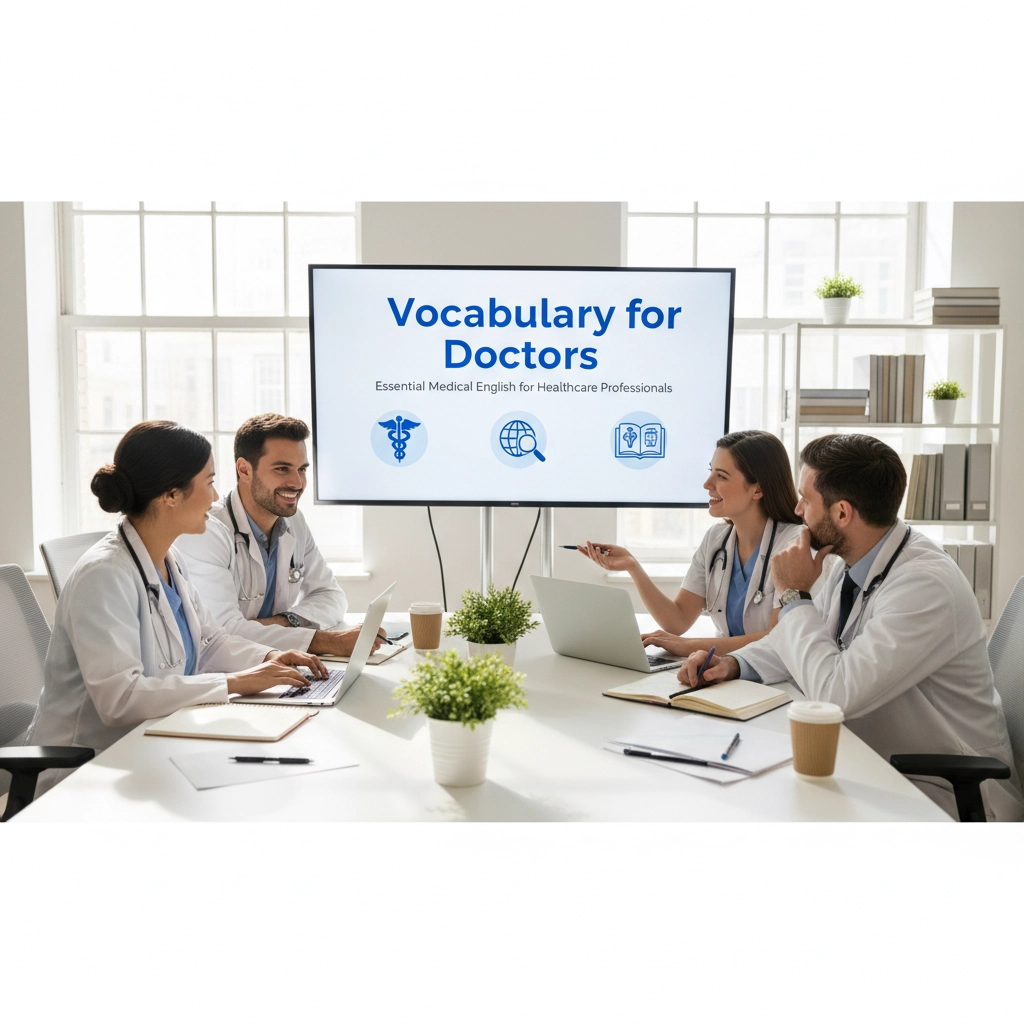Contents
ToggleWorking in healthcare means communicating clearly can literally save lives. Whether you're a doctor treating international patients, a nurse documenting care, or a medical student preparing for clinical rotations, mastering medical English vocabulary is essential for professional success.
In my experience working with healthcare professionals from around the world, I've seen how the right vocabulary transforms not just communication, but confidence in clinical settings. Let's explore the essential medical English terms every healthcare professional needs to know.
Essential Medical Abbreviations and Acronyms
Medical professionals rely heavily on abbreviations to document patient information quickly and accurately. These shorthand terms are used constantly in charts, prescriptions, and verbal communication between staff.
Vital Signs and Measurements
- HR (heart rate) – the number of heartbeats per minute
- BP (blood pressure) – the pressure of blood against artery walls
- RR (respiratory rate) – breaths per minute
- O2 (oxygen) – oxygen saturation levels
- Temp (temperature) – body temperature measurement
Diagnostic Terms
- MRI (magnetic resonance imaging) – detailed internal body imaging
- CT (computed tomography) – cross-sectional X-ray images
- EKG/ECG (electrocardiogram) – heart activity recording
- Labs (laboratory tests) – blood work and other diagnostic tests
- Stat (immediately) – requires immediate attention
Understanding these abbreviations helps you read medical charts efficiently and communicate with colleagues using standard medical language.

Medical Word Parts and Terminology
Medical terminology follows predictable patterns using prefixes, suffixes, and root words. Learning these building blocks helps you understand unfamiliar medical terms instantly.
Common Prefixes
- Hyper- (excessive): hypertension (high blood pressure)
- Hypo- (below normal): hypotension (low blood pressure)
- Brady- (slow): bradycardia (slow heart rate)
- Tachy- (fast): tachycardia (rapid heart rate)
- Pre- (before): preoperative (before surgery)
- Post- (after): postoperative (after surgery)
Body System Root Words
- Cardio (heart): cardiology, cardiovascular
- Gastro (stomach): gastritis, gastroenterology
- Neuro (nervous system): neurology, neurological
- Pulmo (lungs): pulmonary, pulmonologist
- Hepato (liver): hepatitis, hepatology
- Nephro (kidneys): nephrology, nephrologist
Common Suffixes
- -ology (study of): cardiology, dermatology
- -itis (inflammation): arthritis, bronchitis
- -osis (condition): diagnosis, prognosis
- -ectomy (surgical removal): appendectomy, tonsillectomy
These patterns make medical English vocabulary much more manageable once you recognize the system.
Anatomy and Body Systems Vocabulary
Healthcare professionals need precise anatomical terminology to describe patient conditions, document examinations, and communicate findings effectively.
Major Body Systems
- Cardiovascular system: heart, blood vessels, circulation
- Respiratory system: lungs, airways, breathing
- Digestive system: stomach, intestines, digestion process
- Musculoskeletal system: muscles, bones, joints, movement
- Nervous system: brain, spinal cord, nerves
- Endocrine system: hormones, glands, metabolism
Anatomical Positions and Directions
- Anterior/posterior (front/back)
- Superior/inferior (upper/lower)
- Medial/lateral (toward center/toward side)
- Proximal/distal (near/far from body center)
- Dorsal/ventral (back/front)
Using correct anatomical terminology ensures accurate communication about patient conditions and treatment locations.

Common Symptoms and Patient Complaints
Healthcare professionals encounter similar patient symptoms regularly. Having precise vocabulary to describe and document these complaints improves patient care quality.
Pain-Related Terms
- Acute pain: sudden, severe pain
- Chronic pain: long-lasting, persistent pain
- Sharp pain: stabbing, intense sensation
- Dull ache: continuous, mild discomfort
- Throbbing pain: pulsating discomfort
- Radiating pain: pain spreading to other areas
Respiratory Symptoms
- Dyspnea: difficulty breathing or shortness of breath
- Wheezing: whistling sound during breathing
- Cough: productive (with mucus) or dry
- Chest tightness: feeling of pressure in chest area
- Stridor: high-pitched breathing sound
Gastrointestinal Symptoms
- Nausea: feeling sick to stomach
- Vomiting: throwing up stomach contents
- Diarrhea: loose, watery bowel movements
- Constipation: difficulty having bowel movements
- Abdominal pain: stomach area discomfort
Neurological Symptoms
- Dizziness: feeling unsteady or lightheaded
- Syncope: fainting or loss of consciousness
- Headache: pain in head or neck area
- Confusion: difficulty thinking clearly
- Numbness: loss of sensation in body part
Accurate symptom documentation helps ensure proper diagnosis and treatment planning.
Medical Procedures and Treatments
Healthcare involves numerous procedures and treatments that require specific vocabulary for proper documentation and patient communication.
Diagnostic Procedures
- Biopsy: tissue sample removal for examination
- Endoscopy: internal examination using flexible tube
- Ultrasound: imaging using sound waves
- Blood draw/venipuncture: collecting blood samples
- Physical examination: hands-on patient assessment
Therapeutic Interventions
- Surgery: operative procedure to treat condition
- Physical therapy: exercises to restore function
- Medication administration: giving prescribed drugs
- Wound care: cleaning and dressing injuries
- Oxygen therapy: supplemental oxygen delivery
Emergency Procedures
- CPR (cardiopulmonary resuscitation): life-saving technique
- Intubation: inserting breathing tube
- Defibrillation: electric shock to restore heart rhythm
- IV insertion: intravenous line placement
- Suturing: stitching wounds closed
Understanding procedure terminology helps healthcare professionals communicate treatment plans clearly with patients and colleagues.

Hospital Departments and Healthcare Teams
Modern healthcare involves multidisciplinary teams working across various hospital departments. Knowing roles and specialties improves collaboration and patient care coordination.
Medical Specialties
- Cardiology: heart and blood vessel specialists
- Orthopedics: bone and joint specialists
- Pediatrics: children's healthcare specialists
- Geriatrics: elderly patient care specialists
- Oncology: cancer treatment specialists
- Emergency medicine: acute care specialists
Healthcare Professionals
- Attending physician: supervising doctor
- Resident: doctor in specialized training
- Registered nurse (RN): licensed nursing professional
- Licensed practical nurse (LPN): basic nursing care provider
- Pharmacist: medication specialist
- Physical therapist: movement and mobility specialist
- Social worker: patient support services coordinator
Hospital Departments
- Emergency Department (ED): acute care unit
- Intensive Care Unit (ICU): critical patient care
- Operating Room (OR): surgical procedures area
- Recovery Room: post-procedure monitoring
- Laboratory: diagnostic testing facility
- Radiology: medical imaging department
Clear understanding of roles and departments ensures efficient healthcare delivery and proper referrals.
Emergency Medical Terminology
Emergency situations require immediate, clear communication. Emergency medical vocabulary must be precise and universally understood to save lives.
Emergency Conditions
- Cardiac arrest: heart stops beating
- Respiratory failure: breathing stops or inadequate
- Stroke: brain blood supply interrupted
- Hemorrhage: severe bleeding
- Shock: inadequate blood flow to organs
- Trauma: serious injury from accident or violence
Emergency Response Terms
- Code blue: cardiac or respiratory emergency
- Code red: fire emergency
- Triage: prioritizing patients by severity
- Trauma alert: serious injury incoming
- Life support: artificial maintenance of vital functions
- Resuscitation: restoring consciousness or vital signs
Urgency Levels
- Critical: immediate life-threatening condition
- Urgent: serious condition requiring prompt care
- Semi-urgent: needs attention within hours
- Non-urgent: routine care needed
Emergency vocabulary saves precious time when every second counts in critical patient care situations.
Building Your Medical English Confidence
Mastering medical English vocabulary takes time and practice, but the investment pays enormous dividends in your healthcare career. Start with the most common terms in your specialty area, then gradually expand your vocabulary through daily practice.
I recommend keeping a medical vocabulary journal, noting new terms you encounter during shifts or continuing education. Practice using these terms in context, whether documenting patient care or discussing cases with colleagues.
Remember, even experienced healthcare professionals continue learning new medical terminology throughout their careers. Medicine evolves constantly, introducing new procedures, medications, and diagnostic techniques that require updated vocabulary.
The key is consistent, purposeful practice. Focus on accuracy over speed initially. Clear, precise communication protects both patients and healthcare providers from misunderstandings that could compromise care quality.
Your commitment to improving medical English vocabulary demonstrates professionalism and dedication to excellent patient care. This foundation will serve you throughout your healthcare career, opening doors to advancement opportunities and enhancing your ability to provide compassionate, effective treatment.





